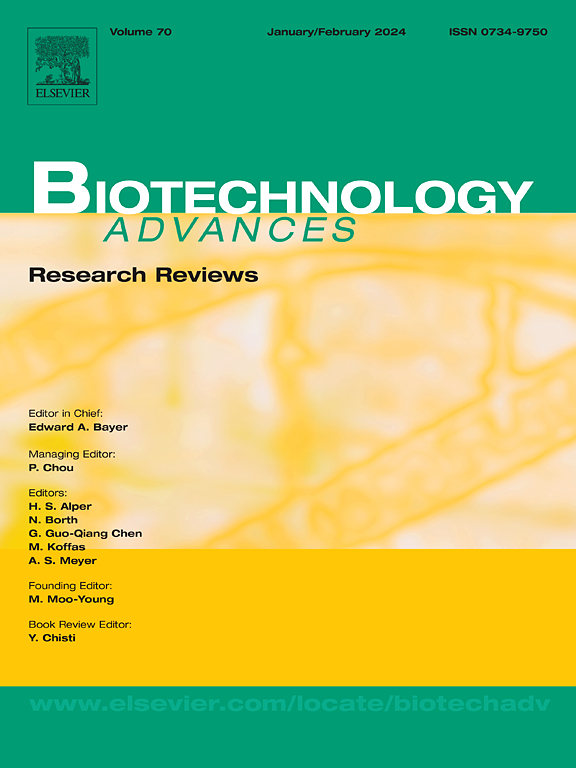Biotechnological production and emerging applications of betalains: A review
IF 12.1
1区 工程技术
Q1 BIOTECHNOLOGY & APPLIED MICROBIOLOGY
引用次数: 0
Abstract
Betalains are food-grade hydrophilic pigments with antioxidant and biological activities, predominantly found in plants. Betanin is a red-violet betalain synthesized from tyrosine through L-DOPA formation, its subsequent aromatic ring-opening, spontaneous cyclization to betalamic acid, and then pH-dependent condensation with i) cyclo‐DOPA-5-O-glucoside or ii) cyclo‐DOPA followed by 5-O-glucosylation. This short pathway in plants for betanin biosynthesis has been heterologously expressed in other organisms (e.g. non-betalainic plants, yeasts, and fungi) using CYP76AD1, DOD1, and cDOPA5GT or B5GT, corresponding to the enzymatic steps mentioned above. For the red-violet color formation through heterologous expression of the pathway genes in non-betalainic plants, a simplified reporter gene called RUBY has been developed recently. Without any systems engineering, expression of RUBY in non-betalainic plants resulted in accumulation of up to 203 mg betalains/100 g fresh weight of peanut leaves. In yeasts, Saccharomyces cerevisiae and Yarrowia lipolytica, and fungus Fusarium venenatum, betanin production has been achieved through overexpression of the pathway genes, with productivity reaching up to 0.62 mg/L/h, 26 mg/L/h, and 26.4 mg/L/h from d-glucose as carbon source, respectively, after considerable systems engineering and gene copy number augmentation. This review critically analyzes recent biotechnological production of betalains to highlight the advancements and strategies for improvement in the technology. Also, emerging applications of betalain biosynthetic gene products or betalains as biosensors, fluorescent probes, meat analog colors, and others are discussed to strengthen the need for systems engineering and process optimization for large-scale industrial production of these pigments.

甜菜碱的生物技术生产和新兴应用综述
甜菜素是具有抗氧化和生物活性的食品级亲水性色素,主要存在于植物中。甜菜素是一种紫红色甜菜素,由酪氨酸通过L-DOPA形成,随后的芳香环开环,自发环化成甜菜酸,然后与i) cycloo‐DOPA-5- o -葡萄糖苷或ii) cycloo‐DOPA进行ph依赖性缩合,然后进行5- o -糖基化。这条植物中甜菜素生物合成的短途径在其他生物(如非甜菜素植物、酵母和真菌)中也有异源表达,使用CYP76AD1、DOD1和cDOPA5GT或B5GT,与上述酶促步骤相对应。对于该途径基因在非甜菜碱植物中异源表达形成红紫色,最近开发了一种简化的报告基因RUBY。在没有任何系统工程的情况下,RUBY在非甜菜碱植物中的表达导致花生叶片累积高达203 mg甜菜碱/100 g鲜重。在酵母、酿酒酵母、解脂耶氏酵母和真菌中,通过过量表达途径基因实现了甜菜素的生产,以d-葡萄糖为碳源,经过大量的系统工程和基因拷贝数增加,产量分别达到0.62 mg/L/h、26 mg/L/h和26.4 mg/L/h。这篇综述批判性地分析了最近甜菜素的生物技术生产,以突出技术的进步和改进策略。此外,还讨论了甜菜素生物合成基因产物或甜菜素作为生物传感器、荧光探针、肉类模拟颜色等的新兴应用,以加强对这些色素大规模工业生产的系统工程和工艺优化的需求。
本文章由计算机程序翻译,如有差异,请以英文原文为准。
求助全文
约1分钟内获得全文
求助全文
来源期刊

Biotechnology advances
工程技术-生物工程与应用微生物
CiteScore
25.50
自引率
2.50%
发文量
167
审稿时长
37 days
期刊介绍:
Biotechnology Advances is a comprehensive review journal that covers all aspects of the multidisciplinary field of biotechnology. The journal focuses on biotechnology principles and their applications in various industries, agriculture, medicine, environmental concerns, and regulatory issues. It publishes authoritative articles that highlight current developments and future trends in the field of biotechnology. The journal invites submissions of manuscripts that are relevant and appropriate. It targets a wide audience, including scientists, engineers, students, instructors, researchers, practitioners, managers, governments, and other stakeholders in the field. Additionally, special issues are published based on selected presentations from recent relevant conferences in collaboration with the organizations hosting those conferences.
 求助内容:
求助内容: 应助结果提醒方式:
应助结果提醒方式:


